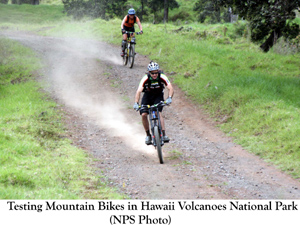There's a new poll for you to take. But it's an old topic: Mountain bikes and national parks.
I first broached the subject in January of 2006. At that time, word had just surfaced that the Park Service and the International Mountain Bicycling Association were embarking on a five-year pilot study of mountain biking in the parks. Well, we're now entering the third year of this study.
 That pilot program called for mountain biking experiments in just three parks -- Big Bend, Fort Dupont, and Cuyahoga Valley. But in addition to those three, IMBA crews are fanning out across the park system to work on projects in a handful of other units. Last summer a crew visited Hawaii Volcanoes National Park to offer trail-building advice and even ran a 15-mile test event.
That pilot program called for mountain biking experiments in just three parks -- Big Bend, Fort Dupont, and Cuyahoga Valley. But in addition to those three, IMBA crews are fanning out across the park system to work on projects in a handful of other units. Last summer a crew visited Hawaii Volcanoes National Park to offer trail-building advice and even ran a 15-mile test event.
The 15-mile route included a 6-mile, 1700' uphill and loop trails over loose gravel, slick grass, and steep rocky stretches, the park noted in a release about the event. To prevent the introduction of non-native plants and insects into the park, rangers helped riders clean their bikes, packs, and shoes before the ride.
Earlier this year an IMBA crew went to Whiskeytown National Recreation Area to again discuss trail building, and even spent an afternoon demonstrating its skills.
Now, Hawaii Volcanoes has allowed mountain biking on existing dirt roads, and I don't think that should be a problem. And Whiskeytown also has a history with mountain biking as part of its general management plan.
What spurs debate, though, is IMBA's lobbying to have single-track trails cut through more and more parks. At Big Bend, the group has its eyes focused on Grapevine Hills, a 20,000-acre slice of landscape that the association says "is pristine and
offers great rolling terrain ideal for a sustainable trail and an engaging
multi-use experience."
At Saguaro National Park, which a dozen years ago opened its 2.5-mile Cactus Forest Trail to mountain bikers, IMBA says it stands ready to help the park design additional mountain biking trails "should they decide to open
additional trails to two-wheeled users."
How compatible are mountain bikes with national parks? Certainly, on existing dirt roads and two-tracks they shouldn't be a problem. Indeed, such opportunities abound across the national park landscape. But is it prudent to open all national parks to mountain biking with the understanding that single-track trails will be cut through the forests, across meadows, and along plateaus to accommodate cyclists?
There are many times when I've come upon moose or bison or elk or deer in the parks while hiking thanks to the quiet nature of hiking. Would that still be the case if trails were opened to mountain bikers, many who head to single tracks for speed and thrills they can't seem to find on dirt roads?
Regarding thrills, there are plenty of places to get an adrenalin rush in national parks: Climbing the Grand Teton or Mount Rainier, caving in Mammoth Cave, paddling Yellowstone's lakes, sea kayaking Acadia's waters. Why do we have to introduce mechanical thrills?
As I'ved noted in the past, there are already many dirt roads open to mountain bikers in the parks, and scores of two- and single-track trails in national forests and BLM lands. Must we introduce more trails in the parks?
What do you think?



Comments